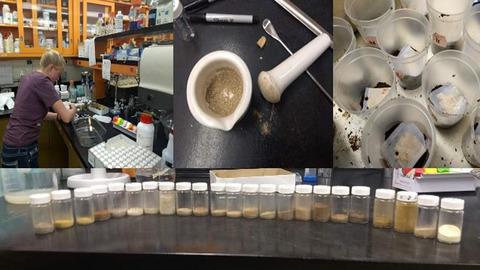当前位置:
X-MOL 学术
›
Funct. Ecol.
›
论文详情
Our official English website, www.x-mol.net, welcomes your
feedback! (Note: you will need to create a separate account there.)
Distinct carbon fractions drive a generalisable two‐pool model of fungal necromass decomposition
Functional Ecology ( IF 4.6 ) Pub Date : 2020-12-06 , DOI: 10.1111/1365-2435.13728 Craig R. See 1 , Chris W. Fernandez 2 , Anna M. Conley 3 , Lang C. DeLancey 1 , Katherine A. Heckman 4 , Peter G. Kennedy 2 , Sarah E. Hobbie 1
中文翻译:

不同的碳馏分驱动真菌性坏死分解的一般化两池模型
更新日期:2020-12-06
Functional Ecology ( IF 4.6 ) Pub Date : 2020-12-06 , DOI: 10.1111/1365-2435.13728 Craig R. See 1 , Chris W. Fernandez 2 , Anna M. Conley 3 , Lang C. DeLancey 1 , Katherine A. Heckman 4 , Peter G. Kennedy 2 , Sarah E. Hobbie 1
Affiliation

|
- Fungi represent a rapidly cycling pool of carbon (C) and nitrogen (N) in soils. Understanding of how this pool impacts soil nutrient availability and organic matter fluxes is hindered by uncertainty regarding the dynamics and drivers of fungal necromass decomposition.
- Here we assessed the generality of common models for predicting mass loss during fungal necromass decomposition and linked the resulting parameters to necromass substrate chemistry. We decomposed 28 different types of fungal necromass in laboratory microcosms over a 90‐day period, measuring mass loss on all types, and N release on a subset of types. We characterised the initial chemistry of each necromass type using: (a) fibre analysis methods commonly used for plant tissues, (b) initial melanin and nitrogen (N) concentrations and (c) Fourier transform infrared (FTIR) spectroscopy to assess the presence of bonds associated with common biomolecules.
- We found universal support for an asymptotic model of decomposition, which assumes that fungal necromass consists of an exponentially decomposing ‘fast’ pool, and a ‘slow’ pool that decomposes at a rate approaching zero. The strongest predictor of the fast pool decay rate (k) was the proportion of cell soluble components, though initial N concentration also predicted k, albeit more weakly. The size of the slow pool was best predicted by the acid non‐hydrolysable fraction, which was positively correlated with melanin‐associated aromatics. Nitrogen dynamics varied by necromass type, ranging from net N release to net immobilisation. The maximum quantity of N immobilised was inversely related to cell soluble contents and k, as positively related to FTIR spectra associated with cell wall polysaccharides.
- Collectively, our results indicate that the decomposition of fungal necromass in soils can be described as having two distinct stages that are driven by different components of substrate C chemistry, with implications for rates of N availability and organic matter accumulation in soils.
中文翻译:

不同的碳馏分驱动真菌性坏死分解的一般化两池模型
- 真菌代表土壤中碳(C)和氮(N)的快速循环池。关于真菌坏死分子分解的动力学和驱动因素的不确定性阻碍了对该池如何影响土壤养分有效性和有机质通量的理解。
- 在这里,我们评估了预测真菌性坏死分解过程中质量损失的通用模型的一般性,并将所得参数与坏死基质化学联系在一起。我们在90天的时间内对28种不同类型的真菌坏死进行了实验室缩影分解,测量了所有类型的质量损失和一部分亚型的N释放。我们使用以下方法对每种坏死类型的初始化学特征进行了表征:(a)植物组织常用的纤维分析方法,(b)初始黑色素和氮(N)浓度,以及(c)傅里叶变换红外(FTIR)光谱法评估是否存在与常见生物分子相关的键。
- 我们发现了对渐进分解模型的普遍支持,该模型假定真菌坏死由指数分解的“快速”池和“缓慢”的池组成,分解速率接近零。快速池衰减速率(k)的最强预测因子是细胞可溶性成分的比例,尽管初始N浓度也预测k,尽管更弱。慢池的大小最好由酸不可水解部分预测,该部分与黑色素相关的芳族化合物呈正相关。氮动力学随坏死类型的不同而变化,从净氮释放到净固定。固定氮的最大量与细胞可溶性含量和k成反比。,与细胞壁多糖相关的FTIR光谱呈正相关。
- 总的来说,我们的结果表明,土壤中真菌坏死的分解可以描述为具有两个不同的阶段,这两个阶段由底物C化学的不同组成部分驱动,这对土壤中氮的利用率和有机质的积累有影响。











































 京公网安备 11010802027423号
京公网安备 11010802027423号